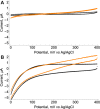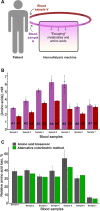Capacitance-Based Biosensor for the Measurement of Total Loss of L-Amino Acids in Human Serum during Hemodialysis
- PMID: 36268654
- PMCID: PMC9706805
- DOI: 10.1021/acssensors.2c01342
Capacitance-Based Biosensor for the Measurement of Total Loss of L-Amino Acids in Human Serum during Hemodialysis
Abstract
In this paper, we present a biosensor based on a gold nanoparticle (AuNP)-modified Pt electrode with an adjusted membrane containing cross-linked L-amino acid oxidase for the detection and quantification of total L-amino acids. The designed biosensor was tested and characterized using the capacitance-based principle, capacitance measurements after electrode polarization, disconnection from the circuit, and addition of the respective amount of the analyte. The method was implemented using the capacitive and catalytic properties of the Pt/AuNP electrode; nanostructures were able to store electric charge while at the same time catalyzing the oxidation of the redox reaction intermediate H2O2. In this way, the Pt/AuNP layer was charged after the addition of analytes, allowing for much more accurate measurements for samples with low amino acid concentrations. The combined biosensor electrode with the capacitance-based measurement method resulted in high sensitivity and a low limit of detection (LOD) for hydrogen peroxide (4.15 μC/μM and 0.86 μM, respectively) and high sensitivity, a low LOD, and a wide linear range for L-amino acids (0.73 μC/μM, 5.5 μM and 25-1500 μM, respectively). The designed biosensor was applied to measure the relative loss of amino acids in patients undergoing renal replacement therapy by analyzing amino acid levels in diluted serum samples before and after entering/leaving the hemodialysis apparatus. In general, the designed biosensor in conjunction with the proposed capacitance-based method was clinically tested and could also be applied for the detection of other analytes using analyte-specific oxidases.
Keywords: L-amino acid oxidase; L-amino acids; capacitance-based biosensor; human serum; hydrogen peroxide.
Conflict of interest statement
The authors declare no competing financial interest.
Figures





Similar articles
-
An amperometric glutamate biosensor based on immobilization of glutamate oxidase onto carboxylated multiwalled carbon nanotubes/gold nanoparticles/chitosan composite film modified Au electrode.Biosens Bioelectron. 2013 Sep 15;47:496-501. doi: 10.1016/j.bios.2013.03.063. Epub 2013 Apr 2. Biosens Bioelectron. 2013. PMID: 23628843
-
Voltage-Switchable Biosensor with Gold Nanoparticles on TiO2 Nanotubes Decorated with CdS Quantum Dots for the Detection of Cholesterol and H2O2.ACS Appl Mater Interfaces. 2021 Jan 27;13(3):3653-3668. doi: 10.1021/acsami.0c19979. Epub 2021 Jan 13. ACS Appl Mater Interfaces. 2021. PMID: 33439005
-
Mediatorless Impedance Studies with Titanium Dioxide Conjugated Gold Nanoparticles for Hydrogen Peroxide Detection.Biosensors (Basel). 2017 Sep 18;7(3):38. doi: 10.3390/bios7030038. Biosensors (Basel). 2017. PMID: 28927005 Free PMC article.
-
A novel strategy for synthesis of hollow gold nanosphere and its application in electrogenerated chemiluminescence glucose biosensor.Talanta. 2014 Oct;128:9-14. doi: 10.1016/j.talanta.2014.03.071. Epub 2014 Apr 4. Talanta. 2014. PMID: 25059123
-
A novel signal-off electrochemiluminescence biosensor for the determination of glucose based on double nanoparticles.Biosens Bioelectron. 2015 Jan 15;63:519-524. doi: 10.1016/j.bios.2014.07.087. Epub 2014 Aug 7. Biosens Bioelectron. 2015. PMID: 25145985 Review.
Cited by
-
A Review from a Clinical Perspective: Recent Advances in Biosensors for the Detection of L-Amino Acids.Biosensors (Basel). 2023 Dec 22;14(1):5. doi: 10.3390/bios14010005. Biosensors (Basel). 2023. PMID: 38248382 Free PMC article. Review.
-
Application of nanoparticles in the diagnosis and treatment of chronic kidney disease.Front Med (Lausanne). 2023 Apr 17;10:1132355. doi: 10.3389/fmed.2023.1132355. eCollection 2023. Front Med (Lausanne). 2023. PMID: 37138743 Free PMC article. Review.
References
Publication types
MeSH terms
Substances
LinkOut - more resources
Full Text Sources
Other Literature Sources

